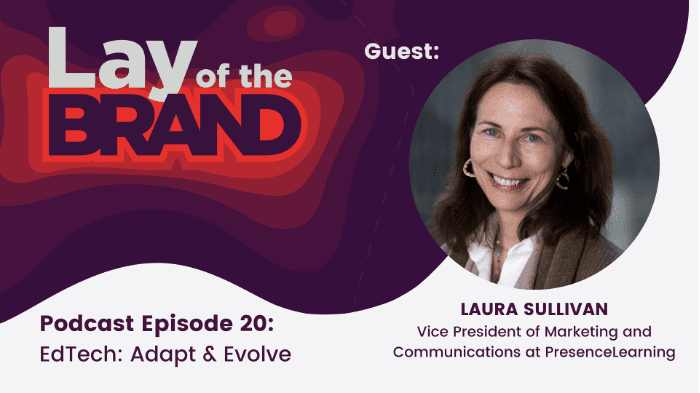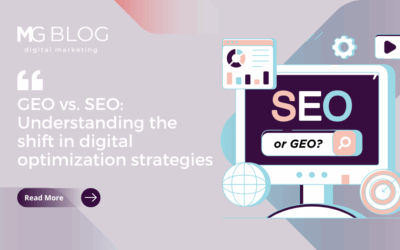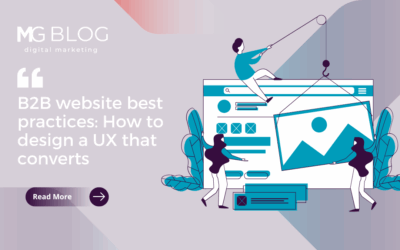
COVID upended learning for K through 12 students and their families — yet the pandemic also accelerated the implementation of EdTech for virtual learning and administration. With school districts across the country again fully embracing classroom learning, we’re taking a look at how the marketing of educational technology has changed in recent times, and where EdTech marketers can find new opportunities with Laura Sullivan, Vice President of Marketing and Communications with PresenceLearning, which provides live online special education-related services to schools nationwide.
Here are the highlights of our conversation. Click below to listen to the podcast or visit layofthebrand.com.
Peter Jacobs, Lay of the Brand:
Virtual teaching solutions have been front and center for the past year and a half, but when thinking about remote learning, schools went to virtual classrooms literally overnight in early 2020. And most had to scramble to get something, anything in place that could do the job and this led to a boom in EdTech providers. Now we’ve got this crowded field, so how do marketers address the issue of, “We’re back in the classroom, our budgets are limited and we have enough remote technology?”
Laura Sullivan, PresenceLearning:
That’s such a good question and we’re all trying to figure out “what do we do, how do we build upon what we did with schools last year” when they were scrambling to get up and running overnight, but they might be in an entirely different kind of reopening strategy and environment today.
One of the things that we think about — and that I spend a lot of time thinking about is — what problems did our technology solve beyond the immediate pandemic needs that might have opened those doors and new opportunities for us, and how do we then take those opportunities and market those additional benefits?
So for example, in the case of PresenceLearning, districts were scrambling to get a solution in place and get up and running quickly to reach their special education students at home, so they can continue to deliver those services to them that are so critical to their education and their health and their progress. And we did solve that immediate need by providing access to our platform that’s designed specifically to deliver those services, and by training school-based clinical teams on the effective delivery of teletherapy which was really new to most of them.
What we’ve found is that districts who are new to PresenceLearning learned what our own providers and current districts had already experienced for years. For instance, many students actually prefer and do better with teletherapy and other online learning modalities, than they do with in-person delivery of services. Districts learned that they can actually better meet the needs of certain individual students and student populations with teletherapy.
School-based clinicians who used our platform for the first time love the breadth of the content and activities that were built right into it. So that means they don’t have to lug around worksheets and workbooks and other tools, they now have all of that content built into an EdTech platform that gives them the ability to personalize and customize that therapy, resulting in greater student engagement.
School psychologists and administrators love that our platform has assessments from top publishers built right into it. They’re not having to source all of those assessments ala carte. That’s saving them time and resources.
For the first time ever, families were getting an up-close view into their children’s therapy or their other online and classroom learning and were able to build relationships with these clinicians and teachers. They don’t want to give that up.
And while districts originally thought of our platform as a teletherapy tool just for the delivery of remote services, they now also look at it as an efficiency tool. Take a large rural district as an example. Instead of their clinicians, or some of their other types of teachers, having to drive from school building to school building throughout the day and losing that valuable time, they’re now able to sit in one location on EdTech platforms and serve more students than they would be able to if they were sitting in their car.
Administrators learned that delivering services remotely really works, which means that now they can offer that flexibility to their clinicians who might not want to come back into the building full time this year either for health reasons, or like the rest of us they’ve come to like a certain amount of flexibility and remote work. So our platform is actually a great staff retention tool that administrators can now use to keep their clinicians or other teachers in the district and also attract the best talent.
So that’s just a quick handful of new use cases for our technology that districts experienced because they brought it in to solve that immediate pandemic problem.
I think marketers need to be looking for those additional post-pandemic benefits of their technology and partner with schools to help them solve those challenges, to really think together about “how do we carry forward and build upon the good?”
Instead of automatically reverting back to normal, which frankly might not have been as good as it could have been, we can highlight what worked last year. I think it’s really on us as the marketers to be sure that we’re identifying those opportunities and the additional benefits of our tools and pointing out that incremental value — so that our customers and our prospects do pay attention to those new use cases and want to continue to build them into their overall models.
For the second part of your question, about marketing messages around being prepared for any situation, not just health issues, I would say yes, a resounding yes. Based on what is going on in the world, particularly around climate change. We will continue to see more and more messages around a broader set of use cases for our technologies.
Even pre-pandemic, we were working with a number of districts across the country who had to close for any variety of reasons ranging from wildfires to hurricanes and tornadoes and earthquakes.
There’s no question that global warming is having a huge impact on the education landscape. And technology will continue to be a significant part of keeping students in school and safe, and learning.
How can marketers pivot to define a much more enduring value proposition?
Peter Jacobs, Lay of the Brand:
The conditions that impact the education world can change in the blink of an eye. Marketers then need to be a lot more adaptable to respond to these kinds of situations and a lot of it can come down to finding ways to recast their solutions and expand into other areas.
Laura Sullivan, PresenceLearning:
I think being adaptable and being flexible, particularly in this environment, really being able to pivot to meet your customers’ changing needs is more critical than it’s ever been. That’s something we were always supposed to be good at, as marketers, but now it’s at a whole different level. When I think about this a few things come to mind that helped PresenceLearning pivot last year and that helped us try to continue to stay responsive, so that we are thought of as an undeniable solution.
Collaboration With Sales
I think this is going to sound cliche but I will say that having an ongoing collaborative dialogue with your sales team is critical to understanding the market and your customer’s needs so you can really adapt and be relevant. I’m not talking about the monthly status meeting that you already have set up. As you mentioned, Peter, the education world, it’s just changing so fast, and it can change on a dime. I think we would argue that it’s still changing. This is still very much in flux.
Partnering with your sales leadership and talking to them daily about what they’re hearing and what messages are really resonating is critical to being able to be sure that you’re always communicating relevant value.
In fact, for our current back-to-school campaign that we’re in the midst of right now, we just shifted some of our messaging mid-campaign based on real-time feedback that we were getting from our school partnership team about what they were learning about our current messaging. It’s not easy to shift messaging mid-campaign. You’ve got everything set and deployed, but it’s so important now to be sure that everything that you’re putting out there makes sense and understanding that, the way things are changing, it might not make sense tomorrow.
Staying Flexible
Being nimble and being willing to pivot — having the mindset that it’s just part of our jobs now to be more flexible and more adaptable than ever really is key. Another important component to creating that enduring value that you were talking about is to be sure that you’re offering your customers stability and the ability to customize and personalize the solutions that they purchased from you
As consumers, we expect that whether we’re selecting the type of Uber car that we want to drive up instead of just getting in the taxi that pulls up in front of us or whether or not we’re customizing our Big Mac.
Whatever it is, as consumers we have the expectation that brands will enable us to personalize our experiences with them. That expectation is no longer just a consumer phenomenon, it’s really something that B2B marketers need to be thinking about: how to offer flexible solutions.
Being in the technology space, we should be able to do that. Technology inherently offers and allows for customization and personalization, so I think being sure that you’re building that into what you’re marketing will help you build those enduring relationships and really stay relevant and connected to your customer’s needs.
Again, because it’s technology, I think it’s incumbent upon us to always be innovating and planning for the future. Stay ahead of your competition. Don’t become a commodity — instead be sure that you’re viewed as a leader, the problem solver and the go-to resource.
Account-based Marketing to Stay Relevant
Peter Jacobs, Lay of the Brand:
I want to touch on something you mentioned about that alignment with your sales team. What you’ve described is an Account-based marketing strategy. Is that how you are approaching this?
Laura Sullivan, PresenceLearning:
More and more, we are looking at account-based marketing, and even regional and local marketing. Because things in our environment and the school landscape are changing so quickly, and because they change based on regional situations, we’ve got to be very thoughtful and careful about segmenting that messaging.
We might have just heard announcements that certain school districts in Oregon are delaying their opening because of a spike in COVID, yet you’ve got school districts in New York racing back in person. It would be crazy for me to be sending marketing messaging to New York, about how to help them connect to their students at home, if they are fully committed to being back in person, but Oregon needs our help immediately on this delayed start and how they can actually get up and running with their students at home.
Segmentation of messaging by locality or account is really becoming important and the best way for us to know about that is that partnership with our sales organization.
We can read things in the news and stay abreast of changes, but really talking to our sales organization every day about where they need different kinds of messaging and support and which accounts they are going after is extremely important.
EdTech Messaging Segmentation
Peter Jacobs, Lay of the Brand:
As we know, there are a lot of decision-makers and influencers in every buying process, but you’re dealing with educators, administrators, the IT organization, the boards of education, etc. How do you message to all of them effectively?
Laura Sullivan, PresenceLearning:
No more one-size-fits-all messaging, right? When COVID hit, we found that more and more people within districts were becoming important influencers to our decision-makers. So for example, we started to see more and more school-based clinicians reaching out to us to get information about our products and services. They were essentially being tasked by their districts with doing some of the research and finding out about all these different tools and technologies that would be able to help them.
So while they aren’t the final decision maker, we realized that they were becoming a really important factor. We started to develop new messaging that spoke directly to them across multiple content formats and deployed it across the channels that they were more engaged in than our traditional decision-makers might have been. So knowing where to find your new influencers is really important too.
You’ve got to keep an eye on how your buyers and influencers are changing and then really take the time to develop a communication strategy that’s personalized just for them to reach them where they are.
In this particular example, we found that these clinicians spend much more time on social media than our traditional decision-makers do. So that informed the type of messaging, content, and channels that we needed to leverage to really engage with them directly.
When you think about different channels and different types of marketing, for us, content marketing has become a larger and larger part of our overall communication strategy. So we’re seeing high levels of engagement in our content which we’re creating on a wide range of topics and in all different formats and putting it out across all of our different channels. We’re finding that it’s really helping us deliver on our brand promise of being a really supportive partner and problem solver for our schools and clinicians.
Content gives us the opportunity to tell compelling stories that really demonstrate our value and relatable ways and it enables us to provide information, training, and support that our audiences really need more than ever in this shifting landscape.
So we’re finding that it’s really much less about pushing out marketing messaging, and much more about engaging in a conversation that’s providing real value and getting back to that enduring relationship.
Peter Jacobs, Lay of the Brand:
What kind of content are you finding to be most effective?
Laura Sullivan, PresenceLearning:
One of the things we’re finding when school districts are making big purchase decisions is they want to know from other school districts that are like them how it works. A district in Texas does not care how it’s working in Maine. They want to know how it’s working for another similar district in Texas.
So we spend a lot of time talking to our customers and developing what we call success stories. They’re essentially case studies that bring to life the problem that they were facing, the solutions that we put in place together, and the results that they’ve experienced. We share those stories in written and video content with similar districts that we’re talking to. So the success story content has been really important for us.
Video in longer and shorter form has also been important. We’re seeing higher engagement in our video content on our website and then we slice and dice it up into shorter content on social channels. We try to do a lot of educational informational content in the form of ebooks, white papers, and webinars.
When we think about the content strategy, we’re really trying to think about full-funnel strategies. What are some of the higher-level thought leadership types of content that we can create to pull people into our ecosystem?
Then, what are some more practical and tactical types of content that can support people that are slightly further down in our funnel, when they’re really looking for more details about how to engage and how to deploy a teletherapy program. That’s another thing that I would say is effective about content — based on the type, you can really work your whole funnel with different types of content.
Peter Jacobs, Lay of the Brand:
Do you find that certain channels are more effective than others and are there some that are being underutilized?
Laura Sullivan, PresenceLearning:
We’re finding social is becoming more and more important for all of our audiences. It’s always been important for us for our clinical audience, but our school district audience is engaging much more with us on LinkedIn these days so we’re spending more and more time on LinkedIn, and Twitter.
Again, different social channels for different audiences and knowing that and finding where they are is important, but we’re continuing to see high levels of engagement there. We do a lot of webinars and informational types of marketing and that channel proves to be very productive for us. Those are a couple that we’re really doubling down on and getting good engagement in.
Top Takeaways for EdTech Marketers
Peter Jacobs, Lay of the Brand:
What would your top takeaways be for EdTech marketers that are looking to differentiate in a very uncertain environment?
Laura Sullivan, PresenceLearning:
I think that being adaptable and being able to pivot and just being sure that is part of your culture, is a really hard thing to do as a marketer. We’re lucky that being nimble and flexible and adapting is part of the DNA of our company that comes right from the top, and I feel very lucky that we have a sales organization that really really is committed to partnering with marketing. We don’t have that typical sales and marketing rub that you sometimes hear about. So, being adaptable, being flexible, and being willing to pivot is key.
You need to be talking to your sales organization all the time to be sure you’re really on top of your customers’ pain points and using that information to adapt messaging. The environment is changing every day.
Set aside resources to experiment. We’re all kind of in this and learning together so try new channels and test different kinds of messaging to see what’s really resonating and working and then build on that. So, experiment, it’s kind of fun.
I would say most importantly, you know, and of course this is going to apply to all marketing, not just in tech, but stay laser-focused on who you are and on your core brand promises and value propositions.
As the market becomes increasingly crowded with new entrants, be sure your customers and your prospects know who you are and what you stand for and resist the temptation to try to be too many things to too many different kinds of people. That dilutes the meaning of your brand.
I’m always keeping an eye on the competitive space and who’s coming in and what everybody’s doing and it’s so tempting to think “we could do that too!” and “we should try that!” or “we should build that!” and I think that there’s a danger in doing that. Of course it’s good to know what’s happening in your landscape but it’s also really important to stay focused on who you are and build your brand.
Want to learn more about EdTech marketing? Listen to this podcast and other episodes at layofthebrand.com or your favorite streaming platform and check out more tips on EdTech digital marketing strategies.



